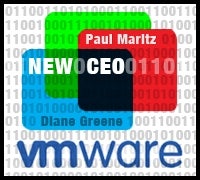 |
IT infrastructure should be treated as ‘a single giant computer on which applications can be provisioned in a more manageable, scalable way.’
In his keynote speech today at VMworld 2008, VMware’s (NYSE: VMW) conference being held through Thursday in Las Vegas, company President and CEO Paul Maritz said the IT infrastructure should be treated as “a single giant computer on which applications can be provisioned in a more manageable, scalable way.” This will enable enterprises to leverage both internal and external clouds.
The focus of IT will also change from devices to the user, according to Maritz. “We need to be able to look at how to equip an individual with the environment that he or she needs, independent of devices,” Maritz said, adding that these changes will be industrywide and will not just be confined to VMware.
Virtualization professionals at the conference said VMware was forced to make these sweeping announcements because of the competitive pressure from Microsoft (NASDAQ: MSFT). One expert thought Maritz’s goals are achievable through incremental steps, but another dismissed his pronouncements as yet another grand blueprint for computing that will fail, like others did before.
VMware will evolve its infrastructure so that any management changes to the infrastructure do not impact the application layer at the load level, Maritz announced. “We want to help IT make sure the infrastructure is reliable, robust, secure without having to predict how it impacts their application load.”
That distinction is critical because application development is changing, Maritz said. He said that the OS as we know it will be deconstructed and made more applicable to the application framework.
We’re All One World
Achieving Maritz’s goal will require widespread industry participation, and he announced two partners immediately helping VMware fulfill his vision. Intel’s (NASDAQ: INTC) Xeon 7400 Series chips, code-named Dunnington ,which were released yesterday, can “do heterogeneous VMotion across different rev levels ‘versions’ of the chips, whereas now you have to make sure you stick within the same chip family,” Maritz said. He explained that companies can currently buy hardware independent of your VMware strategy.
Meanwhile, Cisco Systems (NASDAQ; CSCO) will leverage VMware’s Virtual Datacenter Operating System (VDC-OS), announced at VMworld yesterday to “provide switching services that will let you manage the network seamlessly end to end without having to worry about where the virtual and physical infrastructure boundaries begin and end,” Maritz said. Cisco will make an announcement on this initiative later today.
VMware’s technology will let enterprises leverage both internal and external clouds. External clouds today are not compatible with those within corporate firewalls, Maritz said, adding that “a lot of them require you to write new applications, and they’re all different.”
VMware’s vClouds and vApps initiatives, announced yesterday, will let IT organizations hand over application loads to external cloud vendors. More than 100 third-party cloud vendors support these initiatives.
User focus was a recurrent theme Maritz touched on. “We need to look at how to equip an individual with the environment that he or she needs, independent of devices,” he said. “Users don’t want their lives and information held hostage by a particular device.”
VMware is extending its VDI software with management tools that let enterprise IT specify what applications the individuals should have, independent of the operating system being used. While VDI now works on thin clients, VMware will extend it “to non-PC form factors like personal digital assistants ‘PDAs’ and mobile phones so users and their environment and information will not belong to any device,” Maritz said.
John Premus, chief strategy officer of virtualization consultants and implementers firm Virtera, thinks it’s possible to achieve Maritz’s vision though several interim steps must be taken first. “His vision is the right one, but it’s going to take a little bit of time to get there,” he told InternetNews.com.
Alex Bakman, founder and CEO of virtual appliance maker Vkernel, disagreed. Maritz’s speech “reminds me a little bit of the SAA ‘systems application architecture’ announcement IBM made in the mid-1980s,” Bakman told InternetNews.com.
“SAA was this massive architectural blueprint that would solve all customer problems, but this type of grand vision rarely gets delivered on,” Bakman added. “Five years after its announcement, only 10 percent of the SAA vision was delivered.”
Under Pressure
VMware, however, is under severe pressure, both from internal developments and from Microsoft, and Bakman said this pressure forced Maritz to lay out his vision. “They feel very compelled to tell the world how they’ll continue to innovate,” Bakman said. “There’s nothing more difficult than competing against someone who has billions of dollars of revenue coming in from other sources.”
Trouble arising from internal developments also shaped Maritz’s speech, Bakman said. Maritz gave former CEO Diane Greene and her husband, former VMware chief scientist Mendel Rosenblum, “credit for VMware’s progress” because he had to, Bakman said, adding that “there’s a lot of uneasiness in the ecosystem, and among customers” over their departure.
Greene was ousted unexpectedly in July, and Rosenblum followed her nine weeks later to the day. Speculation that there would be a mass exodus of engineers after Greene’s departure was serious enough that Maritz addressed this issue during VMware’s second quarter earnings call.
Article courtesy of InternetNews.com

